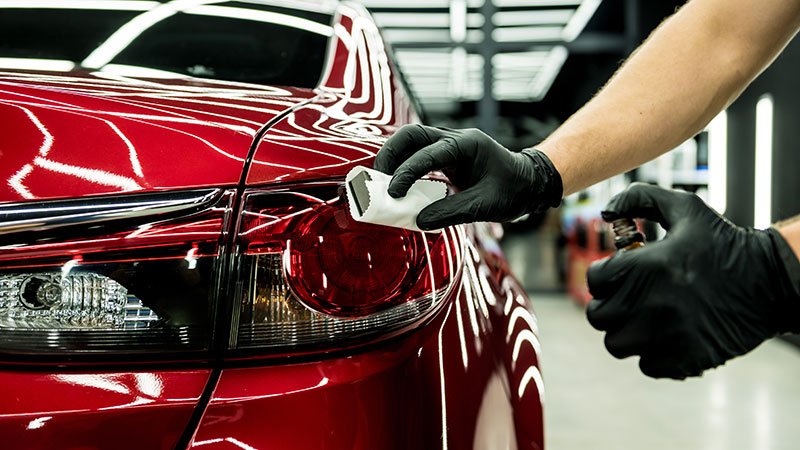Cost-efficient Ceramic Coating Philadelphia Solutions for Elegant Surfaces
Cost-efficient Ceramic Coating Philadelphia Solutions for Elegant Surfaces
Blog Article
Why Ceramic Coating Is the Ultimate Solution for a Flawless End Up
Ceramic layer has become a leading service for those looking for a remarkable finish for their cars, thanks to its remarkable resilience and protective functions. This innovative fluid polymer not only bonds seamlessly with factory paint but additionally offers an awesome obstacle versus typical threats such as scratches, UV rays, and environmental contaminants. Additionally, its hydrophobic buildings simplify maintenance while improving aesthetic charm. However, comprehending just how this technology contrasts to typical techniques and exploring its application subtleties can expose a lot more about its value. What variables absolutely set ceramic finish apart?
What Is Ceramic Finish?

When applied properly, ceramic coating develops a hydrophobic surface area that repels water and dirt, making it easier to keep and clean up. Unlike standard waxes or sealers, which commonly supply brief security, ceramic coatings can last for several years, relying on the item quality and application method. The process of using ceramic finishing requires precise preparation, consisting of comprehensive cleansing and occasionally paint adjustment, to make sure optimum bonding and effectiveness.
Ceramic coverings are not limited to vehicle surfaces; they can likewise be used on different materials, including glass, metal, and plastics, providing a versatile solution for improving security. Generally, ceramic finish represents a significant advancement in surface defense technology, incorporating both practical and aesthetic benefits for a wide variety of applications.
Benefits of Ceramic Coating
While several surface defense alternatives exist, the advantages of ceramic finish stand out as a result of its one-of-a-kind buildings and long-lasting performance. Among the key benefits is its exceptional sturdiness. Ceramic Coating Philadelphia. Unlike traditional wax or sealants that call for frequent reapplication, ceramic finishes offer a resistant layer that can last for several years, dramatically minimizing maintenance initiatives
One more remarkable advantage is enhanced defense against environmental pollutants. Ceramic finishes create a hydrophobic surface that fends off water, dirt, and numerous contaminants, making it easier to clean up. This attribute not only maintains the automobile's appearance however additionally minimizes the danger of corrosion and oxidation, specifically in rough climate condition.
In addition, ceramic finishings supply remarkable resistance to UV rays, stopping fading and degradation of paint with time. This UV defense is crucial for preserving the visual worth of surfaces and lorries exposed to direct sunshine.
In addition, the glossy surface accomplished with ceramic covering improves the overall visual appeal, offering surface areas a showroom-quality sparkle. Generally, ceramic layers represent a considerable development in surface security innovation, supplying long-lasting benefits that cater to both practical and visual demands.
Just How It Functions
Recognizing the scientific research behind ceramic finishings exposes how they provide such remarkable protection and longevity. At its core, a ceramic finishing is a liquid polymer that chemically bonds with the lorry's manufacturing facility paint. This bonding develops a protective layer that is both oleophobic and hydrophobic, repelling water, dust, and oil. The main component of a lot of ceramic finishings is silicon dioxide (SiO2), which is obtained from quartz. This substance adds to the layer's solidity and resistance to scrapes, UV rays, and environmental pollutants.
The application procedure includes multiple steps, including surface prep work, which is essential to great site attaining optimal adhesion. When applied, the covering undergoes a treating process, throughout which it hardens and creates a semi-permanent bond with the paint surface. This bond is what identifies ceramic layers from traditional waxes and sealers, providing a longer-lasting safety barrier that can withstand for years.
In addition, the density of the finish can improve its safety qualities, making sure that it can endure rough problems. Ultimately, the science of ceramic coverings combines advanced materials with cutting-edge application techniques to deliver an unrivaled degree of protection and aesthetic improvement for vehicles.
Comparison With Standard Methods
When contrasted to traditional paint protection techniques such as waxes and sealants,The advantages of ceramic finishes come to be particularly evident. While waxes provide a momentary luster, normally lasting a few weeks to a pair of months, ceramic layers supply a durable protective layer that can withstand for a number of years. This sturdiness substantially lowers the regularity of reapplication, making ceramic layers an extra cost-effective service in time.
Additionally, standard approaches frequently require substantial prep work and several applications to achieve an adequate level of protection. On the other hand, ceramic finishes bond at a molecular level with the lorry's surface, creating a durable guard versus ecological pollutants like UV rays, acid rainfall, and road salts. This bond enhances the vehicle's resistance to scrapes and swirl marks, which prevail with traditional waxes and sealers.
In Discover More addition, the hydrophobic buildings of ceramic coatings ward off water and dust, leading to easier cleansing and maintenance. In contrast, wax and sealant-treated surface areas can bring in gunk, necessitating even more constant washing - Ceramic Coating Philadelphia. Overall, ceramic layers not only provide superior protection however likewise supply a much more aesthetically attractive and long-lasting finish, developing them as the preferred choice for critical automobile proprietors
Application and Upkeep Tips

Making use of a foam applicator, apply the finishing in little sections, complying with the producer's guidelines relating to thickness and overlap. Permit sufficient healing time between coats, usually 24 hr, to ensure correct bonding. After application, it is critical to stay clear of exposure to water or harsh components for a minimum of a week to allow the layer to totally treat.
Furthermore, making use of a ceramic upkeep spray can enhance the coating's hydrophobic residential or commercial properties and longevity. Regular examinations for any kind of signs of wear will assist maintain the covering's honesty and maintain that pristine surface.
Conclusion
In conclusion, ceramic coating emerges as a superior choice for websites accomplishing a perfect vehicle finish. By creating a durable bond with manufacturing facility paint, ceramic finish efficiently shields versus scratches, UV rays, and ecological pollutants.

Report this page